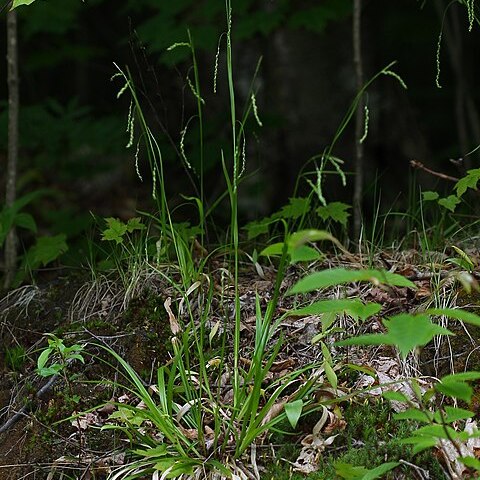Plants densely cespitose. Culms dark maroon at base; flowering stems 20–100 cm, much longer than leaves at maturity, 0.6–1 mm thick, glabrous but scabrous within inflorescence. Leaves: basal sheaths maroon, bladeless, rarely minutely scabrous, glabrous; others grading from maroon to green on back, white to tan-hyaline on front, minutely red dotted; blades flat, 3–10(–13) mm wide, glabrous with minutely scabrous margins. Inflorescences: peduncles of lateral spikes slender, to 30 mm, shorter than spikes; peduncle of terminal spike to 28 mm, usually shorter than adjacent pistillate spikes, minutely scabrous on angles; proximal bracts shorter than inflorescences; sheaths to 30 mm; blades 2–3 mm wide. Lateral spikes 2–5, 1 per node, well separated, erect at anthesis, but soon drooping, pistillate with 15–45 perigynia attached 1–2 mm apart, linear-elongate, 25–80 × 3–4 mm. Terminal spike staminate, sessile or pedunculate, 6–40 × 0.8–2 mm. Pistillate scales white-hyaline with green midrib, oblong-lanceolate, shorter than mature perigynia, apex acuminate to cuspidate or awned, awn to 1.5 mm, margins and awn scabrous or ciliate, otherwise glabrous. Perigynia green, often red dotted, 2-ribbed and finely 10–15-veined, loosely enveloping achene, ellipsoid-ovoid, 3–5 × 1–2 mm, membranous, base with stipe 2–3 mm, apex tapering to minute beak, glabrous but sometimes ciliate between apical teeth; beak bidentate, 0.7–1.5 mm. Achenes sessile, 1.7–2.6 × 0.8–1.7 mm. 2n = 52, 54, 56.
More
Densely tufted, 3–8 dm, purplish at base; main stem-lvs 3–5 mm wide, those of the sterile shoots 3–8 mm wide; staminate spike 1–3 cm, rarely pistillate distally; pistillate spikes 3–5, very slender, 2–6 cm, the upper approximate, the lower well separated, drooping or spreading, very loosely fld; bracts all sheathing, the upper with much reduced setaceous blade; pistillate scales ovate or oblong, the body much shorter than the perigynium, many or all tipped with a short cusp, the whole usually three-fourths as long as the perigynium, but sometimes distinctly surpassing it; perigynia glabrous, narrowly ovoid, trigonous, 3.2–4.8 mm, abruptly narrowed to a short stipe, conspicuously 2-ribbed, finely and usually obscurely several-nerved, narrowed above to a short beak; achene concavely trigonous. Moist rich woods; Nf. to Minn., s. to Pa. and O.

